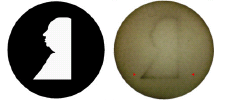Ginkgo.Your Innovation Partner.

One of Ginkgo's favorite biological engineers - Jeff Tabor, has just published his latest engineered biological system, a bacterial edge detector, in Cell Magazine.

The edge detector is a great example of combining different biological parts (light sensors, cell-to-cell signaling molecules, reporters, and logic gates) to make a complicated engineered biological system. In the final system, the engineered E.coli are spread in a lawn on a petri dish and light is shown on the dish in a particular shape. The bacteria at the edge of the shape detect that they are at the interface between light and dark (this is the really amazing bit that requires communication between neighboring cells and some genetically-encoded logic) and express a reporter protein creating an outline of the shape.
This project was actually begun by Jeff and the UT Austin iGEM team in the 1st iGEM competition in 2004. During the 4 months of the competition they didn't manage to get the edge detector working, but they did build the first bacterial photography system ("Coliroid") which was later published in Nature.
Hopefully Jefff's success with the edge detector will be an inspiration for this year's iGEM teams to go after ambitious projects!
Posted by Jason Kelly